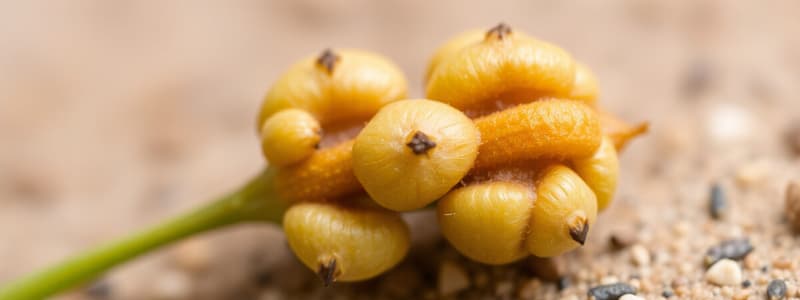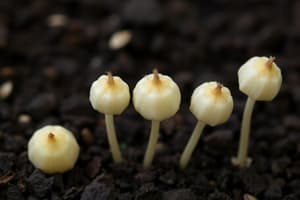Podcast
Questions and Answers
What is the primary purpose of dormancy in seeds?
What is the primary purpose of dormancy in seeds?
- To conserve energy. (correct)
- To accelerate germination.
- To enhance growth.
- To increase metabolic activity.
What causes seed coat dormancy?
What causes seed coat dormancy?
- Chemical substances within the seed.
- Hard and impermeable seed coats. (correct)
- Soft seed coats allowing embryo expansion.
- Incomplete fruit maturation.
Which method is NOT used to overcome seed dormancy?
Which method is NOT used to overcome seed dormancy?
- Cold stratification.
- Increased sunlight exposure. (correct)
- Acid treatment.
- Mechanical scarification.
What characterizes dormancy due to rudimentary embryos?
What characterizes dormancy due to rudimentary embryos?
Which type of dormancy involves both seed coat dormancy and embryo dormancy?
Which type of dormancy involves both seed coat dormancy and embryo dormancy?
What is a common characteristic of seeds experiencing dormancy due to chemical inhibitors?
What is a common characteristic of seeds experiencing dormancy due to chemical inhibitors?
What effect does cold stratification have on seeds?
What effect does cold stratification have on seeds?
Which example signifies dormancy due to internal factors?
Which example signifies dormancy due to internal factors?
What is the purpose of soaking seeds in hot water followed by cold water?
What is the purpose of soaking seeds in hot water followed by cold water?
What does cold stratification involve for seed germination?
What does cold stratification involve for seed germination?
Which of the following is used to stimulate seed germination through chemical treatment?
Which of the following is used to stimulate seed germination through chemical treatment?
What is the expected duration for cold stratification of seeds?
What is the expected duration for cold stratification of seeds?
During the acid treatment process, how long are seeds typically soaked in concentrated acid?
During the acid treatment process, how long are seeds typically soaked in concentrated acid?
What role does dry storage play in seed germination?
What role does dry storage play in seed germination?
Which hormones are known to increase during the cold stratification process?
Which hormones are known to increase during the cold stratification process?
What type of seeds may need to undergo dry storage for successful germination?
What type of seeds may need to undergo dry storage for successful germination?
Flashcards are hidden until you start studying
Study Notes
Dormancy
- Dormancy is a period of suspended growth, development and activity in an organism's life cycle.
- Dormancy helps organisms conserve energy.
- A dormant seed is not a failure.
- Dormancy can be caused by seed characteristics or by surrounding conditions.
Dormancy Types
- Seed coat dormancy: Seed coats are hard and impermeable to oxygen and soil, preventing germination. Examples include Malvaceae.
- Rudimentary Embryo dormancy: Embryos are not fully mature when seeds are released, requiring additional time to develop. Examples include Pinus sp. and palms.
- Chemical inhibitor dormancy: Seeds contain chemical substances that inhibit germination, but these are often removed by leaching or water adsorption.
- Internal factor dormancy: Embryos are physiologically dormant, meaning they don't grow even when environmental conditions are suitable. They require specific conditions for germination, such as moist chilling treatment. Examples include freshly harvested seeds of apple, grape, peach, and apricot.
- Double dormancy: Seeds exhibit both seed coat and embryo dormancy. Examples include Cercis occidentals.
Dormancy Breaking Techniques
- Mechanical scarification: Scarification involves breaking or scratching a seed's hard coat to allow for germination.
- Soaking in water: Seeds are soaked in water, often hot then cold, to soften the seed coat and remove inhibitors.
- Acid treatment: Soaking seeds in concentrated hydrochloric or sulfuric acid can modify the seed coat and aid germination.
- Cold stratification: Seeds undergo cold treatment in moist conditions to facilitate physiological changes within the embryo, leading to germination. This typically involves placing seeds in moist mediums like sand, peat, or vermiculite, and holding them at temperatures slightly above freezing for varying periods, often 1 to 4 months.
- Dry storage: Dry storage is used to promote after-ripening in seeds. Freshly harvested seeds often need a period of dry storage before they germinate.
- Chemical treatment: Chemicals like potassium nitrate, gibberellic acid, or thiourea can be used to stimulate the germination of different seed types.
Studying That Suits You
Use AI to generate personalized quizzes and flashcards to suit your learning preferences.




